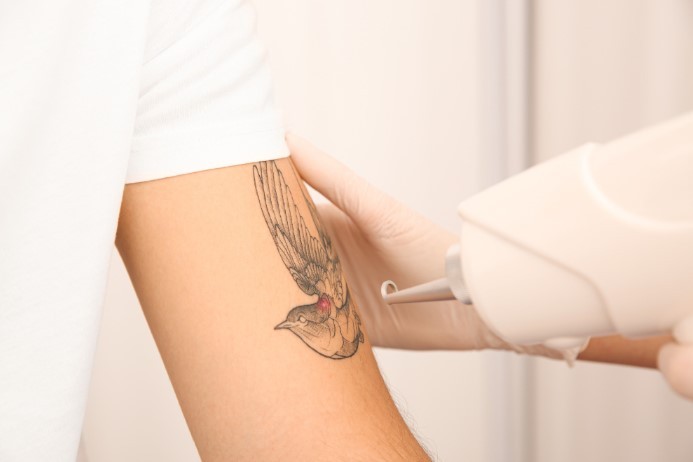Tattoo Removal in Austin: The Ultimate Guide to Reversing Regrets

Key Takeaways:
- Understanding the psychology behind tattoo regrets.
- Cultural shift in attitudes towards tattoos leading to an increase in tattoo regrets.
- Celebrities like Megan Fox and 50 Cent have gone through tattoo regret and removal.
- Laser tattoo removal is the most popular method for removing tattoos in Austin.
- Choose a qualified tattoo removal specialist for safety and effectiveness.
- Alternative tattoo removal techniques include surgical excision and tattoo removal creams.
- Tattoo fading and blurring can be addressed with tattoo removal or cover-up options.
- Tattoo allergies and infections can be prevented through proper sanitation and hygiene.
- Consider the pros and cons of cover-up tattoos versus tattoo removal.
- Initial consultation and assessment determine the personalized treatment plan.
- Expect some pain, recovery, and aftercare after the tattoo removal procedure.
- Managing expectations regarding the number of sessions and final results is important.
1. Understanding Tattoo Regrets: Why People Choose Tattoo Removal in Austin
Getting a tattoo is a personal choice that many people make to express their individuality, commemorate a special event, or simply adorn their bodies with art. However, for some individuals, the decision to get a tattoo may eventually lead to regret. There are various reasons why people choose tattoo removal in Austin, and understanding the psychology behind tattoo regrets can provide valuable insights.
1.1 The Psychology Behind Tattoo Regrets
Tattoo regrets often stem from a change in personal preferences, evolving tastes, or significant life events. What may have once been a cherished design might no longer align with an individual’s current values, beliefs, or image. Additionally, tattoos acquired during impulsive moments or under the influence of substances can also lead to regrets later on.
Furthermore, tattoos can symbolize past relationships, traumatic experiences, or stages of life that individuals may want to move on from. As people grow and change, they may find that their tattoos no longer reflect who they are or want to be.
1.2 Cultural Shift: Attitudes towards Tattoos and the Rise in Tattoo Removal
Over the years, there has been a significant shift in societal attitudes towards tattoos. Once considered rebellious or associated with alternative subcultures, tattoos have now become more mainstream and socially acceptable. However, this normalization has also contributed to an increase in tattoo regrets.
As tattoos become more commonplace, individuals may feel pressured to conform to societal norms or maintain a professional appearance. Job opportunities, particularly in conservative industries, may be limited for individuals with visible tattoos. This has led to an increase in the number of people seeking tattoo removal to enhance their career prospects or simply conform to social expectations.
1.3 Celebrities Who Have Gone through Tattoo Regret and Their Stories
Celebrities often serve as trendsetters and influencers, and their experiences with tattoo regrets can shed light on the emotional impact of unwanted tattoos. Several well-known personalities have publicly shared their journey of tattoo removal, which resonates with people facing similar regrets.
One such example is actress Megan Fox, who had a tattoo of Marilyn Monroe on her forearm. Later, she decided to have it removed as she felt it no longer represented her true self. Similarly, rapper 50 Cent underwent extensive tattoo removal to transition into more versatile acting roles.
These celebrity stories highlight the fact that even individuals in the public eye can experience tattoo regrets and seek tattoo removal as a means of personal growth and self-expression.
2. The Science of Tattoo Removal: How It Works
Tattoo removal is a complex process that requires specialized techniques to effectively eliminate tattoo ink from the skin. The most popular and widely used method for tattoo removal in Austin is laser tattoo removal.
2.1 Laser Tattoo Removal: The Most Popular Method
Laser tattoo removal works by using high-intensity laser beams to break down the tattoo ink into smaller particles. These smaller ink particles are then gradually eliminated by the body’s natural processes.
During the laser tattoo removal procedure, the laser targets the pigment in the tattoo ink without damaging the surrounding skin. The number of sessions required for complete tattoo removal depends on various factors, including the size, color, and age of the tattoo.
It’s essential to choose a qualified tattoo removal specialist who has experience with laser technology. They will be able to determine the appropriate laser settings and devise a personalized treatment plan to achieve optimal results.
2.2 The Importance of Choosing a Qualified Tattoo Removal Specialist
Choosing a qualified tattoo removal specialist in Austin is crucial to ensure the safety and effectiveness of the tattoo removal procedure. A skilled specialist will have in-depth knowledge of laser technology, understanding how different tattoo pigments respond to specific wavelengths.
Before undergoing laser tattoo removal, it’s important to schedule an initial consultation with the specialist. During this consultation, the specialist will assess the tattoo and the individual’s skin type to determine the best course of action.
Working with a qualified specialist reduces the risk of complications, such as scarring or skin discoloration. They will also provide detailed instructions for pre and post-treatment care to optimize the results of the tattoo removal procedure.
2.3 Alternative Tattoo Removal Techniques: Exploring Other Options
While laser tattoo removal is the most popular method, there are alternative tattoo removal techniques available for individuals who may not be suitable candidates for laser treatment.
One such technique is surgical excision, which involves surgically removing the tattooed skin and stitching the surrounding skin together. This technique is usually reserved for smaller tattoos or cases where laser tattoo removal may not be effective.
Another alternative is tattoo removal creams, which claim to fade the tattoo over time. These creams typically contain bleaching agents that gradually lighten the tattoo pigment. However, the effectiveness of tattoo removal creams varies, and they may not completely eliminate the tattoo.
It’s important to consult with a tattoo removal specialist to determine the most suitable technique based on the individual’s specific tattoo and skin type.
3. Tattoos Gone Wrong: Common Tattoo Mistakes and How to Fix Them
While tattoos can be beautiful expressions of art, there are instances where they don’t turn out as expected. Understanding common tattoo mistakes and the available solutions can help individuals make informed decisions regarding tattoo removal in Austin.
3.1 Tattoo Fading and Blurring: Aesthetic Concerns
Over time, tattoos may fade or blur, losing their original vibrancy and clarity. Factors such as sun exposure, improper aftercare, or low-quality ink can contribute to tattoo fading. Additionally, as the skin ages and undergoes natural changes, the appearance of the tattoo may also be affected.
For individuals experiencing tattoo fading or blurring, tattoo removal or cover-up options are available. Laser tattoo removal can effectively remove the faded tattoo, providing a clean canvas for a new design or complete removal if desired.
Cover-up tattoos are another popular solution for faded tattoos. A skilled tattoo artist can design a new tattoo that incorporates and conceals the existing design, giving it a fresh and updated appearance.
3.2 Tattoo Allergies and Infections: Health Risks and Precautions
Some individuals may develop allergic reactions or infections to tattoo ink. Allergies can manifest as skin rashes, itching, or swelling, while infections can result in pain, redness, or pus formation.
If an allergic reaction or infection occurs, seeking medical attention is crucial to address the issue promptly. In some cases, tattoo removal may be recommended to eliminate the source of the reaction or infection.
Preventing tattoo allergies and infections involves ensuring proper sanitation and hygiene during the tattooing process. Choosing a reputable tattoo artist who follows strict sterilization practices and uses high-quality ink can significantly reduce the risk of complications.
3.3 Cover-up Tattoos versus Tattoo Removal: Pros and Cons
When faced with a tattoo mistake or regret, individuals have two primary options: cover-up tattoos or tattoo removal.
Cover-up tattoos involve creating a new design that incorporates elements of the existing tattoo to conceal it. This option can be a cost-effective solution and allows individuals to transform their unwanted tattoo into a new, meaningful piece of art.
However, cover-up tattoos may not always be a feasible option, especially if the existing tattoo is large, dark, or contains intricate details. In such cases, tattoo removal provides a more reliable and comprehensive solution by completely eliminating the unwanted tattoo.
It’s essential to weigh the pros and cons of each option, considering factors such as the size, location, and appearance of the existing tattoo, as well as personal preferences and desired outcomes.
4. Navigating the Tattoo Removal Process: What to Expect in Austin
Embarking on the tattoo removal process can feel overwhelming, but understanding the steps involved and what to expect can help individuals navigate the journey with confidence.
4.1 Initial Consultation and Assessment: Creating a Personalized Treatment Plan
The first step in the tattoo removal process is scheduling an initial consultation with a tattoo removal specialist in Austin. During this consultation, the specialist will assess the tattoo, discuss the individual’s goals and expectations, and determine the most suitable treatment plan.
Factors such as the size, color, and location of the tattoo, as well as the individual’s skin type, will be taken into account when creating a personalized treatment plan. The specialist will also provide an estimate of the number of sessions required and the expected cost.
4.2 The Tattoo Removal Procedure: Pain, Recovery, and Aftercare
During the tattoo removal procedure, the specialist will use laser technology to target and break down the tattoo ink. The sensation experienced during the procedure can vary, with some individuals describing it as similar to a rubber band snap or the feeling of a hot rubber band on the skin.
After the procedure, the treated area may appear red, swollen, or blistered. This is a normal part of the healing process and typically subsides within a few weeks. The specialist will provide detailed aftercare instructions to promote healing and prevent complications.
4.3 Managing Expectations: Number of Sessions and Results
Managing expectations regarding the number of tattoo removal sessions and the final results is crucial. Tattoo removal is an ongoing process that requires multiple sessions spaced several weeks apart to allow the skin to heal.
The number of sessions required depends on various factors, including the size, color, and depth of the tattoo, as well as the individual’s skin type and response to treatment. It’s important to understand that complete tattoo removal may not always be achievable, particularly with multi-colored or densely pigmented tattoos.
However, significant fading or removal of the tattoo can often be achieved with consistent treatment and proper aftercare. The tattoo removal specialist will provide a realistic assessment of the expected results based on the individual’s unique situation.
In conclusion, tattoo removal in Austin offers individuals the opportunity to reverse their tattoo regrets and move forward confidently. Understanding the psychology behind tattoo regrets, the science of tattoo removal, common tattoo mistakes, and the tattoo removal process empowers individuals to make informed decisions about their tattoos. By working with qualified specialists and exploring various removal techniques, individuals can find the most suitable solution for their tattoo removal needs.
FAQ
Question: Why do people choose tattoo removal in Austin? – People choose tattoo removal in Austin for various reasons such as a change in personal preferences, evolving tastes, significant life events, or wanting to move on from past relationships or traumatic experiences.
Question: How has the cultural shift towards tattoos impacted tattoo regret and removal? – The cultural shift towards tattoos becoming more mainstream and socially acceptable has contributed to an increase in tattoo regrets. Individuals may feel pressured to conform to societal norms or maintain a professional appearance, leading them to seek tattoo removal to enhance their career prospects or conform to social expectations.
Question: Can celebrities also experience tattoo regrets? – Yes, celebrities like Megan Fox and 50 Cent have publicly shared their experiences with tattoo regret and removal. These stories highlight that even individuals in the public eye can seek tattoo removal as a means of personal growth and self-expression.
Question: What is laser tattoo removal and why is it the most popular method in Austin? – Laser tattoo removal is a method that uses high-intensity laser beams to break down tattoo ink into smaller particles, which are then gradually eliminated by the body. It is the most popular method in Austin because it is effective at targeting tattoo pigment without damaging the surrounding skin.
Question: Why is it important to choose a qualified tattoo removal specialist? – Choosing a qualified specialist is crucial for the safety and effectiveness of the tattoo removal procedure. They have in-depth knowledge of laser technology, understand how different tattoo pigments respond to specific wavelengths, and can create a personalized treatment plan based on the individual’s tattoo and skin type.
Question: Are there alternative tattoo removal techniques besides laser tattoo removal? – Yes, there are alternative techniques such as surgical excision and tattoo removal creams. Surgical excision involves surgically removing the tattooed skin, while tattoo removal creams claim to fade the tattoo over time. It’s important to consult with a specialist to determine the most suitable technique based on the individual’s specific tattoo and skin type.
Question: How can tattoo fading and blurring be addressed? – Tattoo fading and blurring can be addressed through tattoo removal or cover-up options. Laser tattoo removal can effectively remove the faded tattoo, providing a clean canvas for a new design or complete removal if desired. Cover-up tattoos are another option where a skilled tattoo artist designs a new tattoo that incorporates and conceals the existing design.
Question: What are the risks of tattoo allergies and infections, and how can they be prevented? – Some individuals may develop allergic reactions or infections to tattoo ink, resulting in skin rashes, itching, swelling, or pain. Preventing tattoo allergies and infections involves ensuring proper sanitation and hygiene during the tattooing process, choosing a reputable tattoo artist, and using high-quality ink. Seeking medical attention promptly is crucial if an allergic reaction or infection occurs.
Useful Resources:
- Psychology Today – A website providing articles and resources on the psychology behind tattoo regrets.
- Mayo Clinic – A trusted source for information on tattoo removal techniques and procedures.
- Healthline – A reliable website offering educational articles and resources on tattoo removal and related topics.
- WebMD – A comprehensive resource for understanding the science of tattoo removal and the various methods available.
- Tattoodo – An online platform dedicated to the art of tattooing, providing inspiration and information on cover-up tattoo options.
- American Academy of Dermatology – A professional association that offers information on tattoo allergies, infections, and prevention measures.
- Austin PicoSure – A specialized tattoo removal clinic in Austin, offering laser tattoo removal services with qualified specialists.
- WikiHow – A user-edited platform providing step-by-step guides on various topics, including tattoo removal and aftercare.







